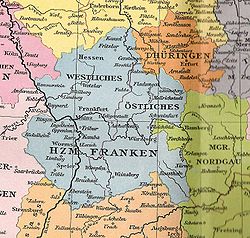- Duchy of Franconia
-
Duchy of Franconia Stem duchy of the German Kingdom ← 906–939  →
→
 →
→
 →
→Capital Not specified Religion Roman Catholic Political structure Vassal Historical era Middle Ages - Established 906 - Disestablished 939 The Duchy of Franconia was one of the stem duchies of Germany during the formative period of the Holy Roman Empire in the 10th century, part of former Frankish Austrasia. But unlike the others Franconia did not evolve into a stable political entity. Its first duke was elected to the King of the Germans in 911 and was succeeded by his brother who died in 939 when he revolted against another German king. This king did not appoint a new duke of Franconia, the duchy was fragmented into several counties and bishoprics, which were subordinated to the German kings directly. In the western part of Franconia (Rheinfranken) were there several counties that belonged to the Salian dynasty. Its members were sometimes mentioned as dukes of Franconia and they became Germany's royal dynasty in 1024. Their Franconian territories were in 1093 granted as a fief to the palatine count of Aachen, which would evolve into the important German principality of Electoral Palatinate (Kurpfalz).
The Franconian stem duchy was seized by King Otto I of Germany after the unsuccessful revolt of the Conradine duke Eberhard had shattered at the 939 Battle of Andernach. With the advancement of Count Conrad the Red, Rhenish Franconia became the heartland of the Imperial Salian dynasty, which provided four emperors in the 11th and 12th centuries: Conrad II, Henry III, Henry IV, and Henry V. It contained the cities of Mainz, Speyer and Worms, the latter two being the administrative centres of countships within the hands of the Salian descendants of Conrad the Red. These counts were sometimes referred to informally, on account of the great power in the region, as Dukes of Franconia.
Emperor Conrad II was last to bear the ducal title. When he died in 1039, Rhenish Franconia was governed as a constellation of small states, like the cities of Frankfurt, Speyer and Worms, the Prince-bishoprics of Mainz, Speyer, and Worms, as well as the Landgraviate of Hesse, then part of Thuringia. Alongside these powerful entities there were many smaller, petty states. In 1093, Emperor Henry IV gave the Salian territories in Rhenish Franconia as a fief to Henry of Laach, the Count palatine of Lower Lorraine at Aachen, his lands then would evolve into the important principality of the Electoral Palatinate. While Emperor Frederick Barbarossa in 1198 granted the ducal title to the Prince-Bishops of Würzburg in Eastern Franconia, Rhenish Franconia was divided and extinguished. Its territories became part of the Imperial Upper Rhenish Circle in 1500.
References
- Franken. article in: Meyers Konversations-Lexikon, 4. Aufl. 1888–1890, Bd. 6, S. 491 f.
Categories:- Former countries in Europe
- States of the Holy Roman Empire
- History of Germany in the Middle Ages
- 10th century in Germany
Wikimedia Foundation. 2010.

